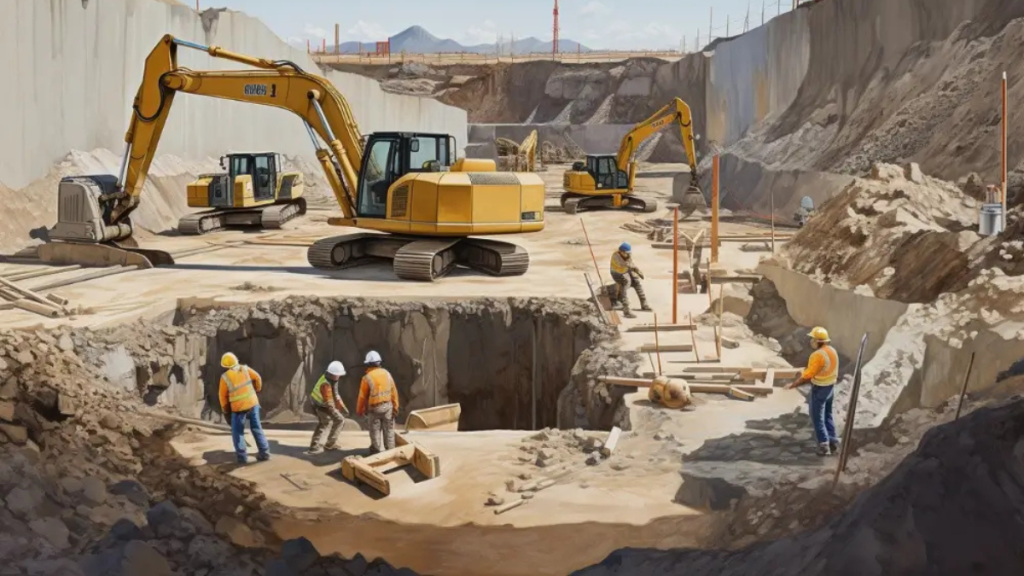Excavation work is a critical component in the construction sectors across Australia. Whether it’s a residential build, a commercial development, or a major infrastructure project, excavation is the first step in transforming land for future use. But this process is not without risk.
Excavation work, particularly in dense urban environments like Sydney, presents a complex range of hazards that need to be carefully managed. In this guide, we unpack the key risks associated with excavation work and explain how to mitigate these dangers.
Hazards Involved in Excavation Projects
1. Trench Collapses and Cave-ins
If the walls of an excavation become unstable, the soil can suddenly shift and collapse, burying workers beneath tons of debris. This risk is particularly high in deep excavations or areas with unstable soil conditions.
Mitigation:
- Workers must use trench shields or trench boxes for shallow excavations.
- For deep excavations, shoring systems should be implemented to reinforce trench walls.
- Assess soil stability before excavation.
- Install appropriate safety barriers and support structures.
2. Falling Equipment
Tools, equipment, and debris can accidentally fall into the excavation, posing serious harm to workers below. This is especially dangerous if the excavation is deep or workers are not aware of potential falling objects.
Mitigation:
- Secure tools and equipment to prevent falling.
- Install barricades or safety barriers around the excavation site.
- Keep materials at least 2 feet away from the edge of the excavation.
- Use retaining devices to secure materials.
3. Hazardous Air Quality
Excavation work in confined spaces can result in hazardous air quality. Toxic gases such as methane, carbon monoxide, or hydrogen sulfide can accumulate, or oxygen levels may become dangerously low. This can lead to asphyxiation or poisoning, especially in deeper trenches or when working around underground utilities.
Mitigation:
- Conduct atmospheric testing before entry, particularly for excavations deeper than 1.5 metres.
- Provide proper ventilation to maintain air quality.
- Equip workers with respiratory protection when necessary.
- Keep lifesaving equipment, such as a breathing apparatus, readily available.
4. Accidental Damage of Underground Infrastructure
Accidentally damaging underground utilities such as water pipes, gas lines, and electrical cables can cause severe accidents, including explosions, electrical shocks, or flooding. These utilities are often difficult to locate, and the risks of hitting them during excavation work are significant if they aren’t marked correctly.
Mitigation:
- Conduct utility mapping before excavation.
- Verify utility locations with local authorities and utility companies.
- Mark underground utilities clearly at the excavation site.
5. Heavy Machinery Incidents
Heavy machinery such as backhoes, bulldozers, and cranes pose a significant risk on excavation sites. Improper operation or lack of awareness can lead to severe injuries or fatalities.
Mitigation:
- Maintain clear work zones around heavy machinery.
- Conduct regular maintenance on excavation equipment.
- Use spotters or flaggers to guide machine operators.
6. Weather Conditions
Severe weather conditions such as heavy rain, extreme heat, or strong winds, can increase the risks associated with excavation work. Rain can make the soil slippery, increase soil instability, and lead to flooding in excavations. Extreme heat can cause dehydration or heat stress in workers.
Mitigation:
- Monitor weather forecasts and pause work during severe weather.
- Implement drainage systems to prevent water accumulation in excavations.
- Use protective coverings to shield workers and materials.
- Ensure workers stay hydrated and have access to shaded areas for relief from the heat
7. Proximity to Traffic and Public Spaces
Excavation sites near busy roads or public areas are at an increased risk of accidents. The presence of traffic and pedestrians increases the likelihood of accidents involving workers or the public, especially if safety barriers are not in place.
Mitigation:
- Use barricades, signage, and flaggers to direct traffic safely around the site.
- Restrict public access to the excavation site.
- Ensure clear visibility for operators and workers to avoid collisions.
- Follow traffic management plans and local regulations.
Critical Importance of Adequate Safety Measures in Excavation Work
In excavation work, safety measures are highly important. Inadequate training, lack of proper equipment, and poor site inspections expose workers to dangers, increasing the risk of confusion, miscommunication, and human error, all of which can have catastrophic consequences.
Unclear safety procedures lead to risks and failure to recognise warning signs, making the situation even more dangerous. Implementing comprehensive safety measures is not just a legal requirement but a responsibility to protect workers and ensure project success.
Excavation in Sydney: Choosing the Right Contractor
Selecting a contractor for excavation in Sydney requires choosing a company that places a strong emphasis on safety, reliability, and expertise. Look for contractors with:
- A strong safety record
- Verified certifications and insurance
- Local experience with Sydney’s soil and regulatory conditions
- A wide fleet of excavation equipment
- Transparent communication and planning processes
Sydney excavation requires adherence to regulations and careful planning. Partnering with a reputable excavation company ensures the project remains on track and workers stay protected.
Final Thoughts
Excavation work comes with inherent risks, but with the right planning, personnel, and procedures, those risks can be managed.
By working with reliable excavation contractors, you not only reduce your exposure to hazards but also improve your project’s overall success.
When planning a project requiring excavation in Sydney, make sure your contractor is qualified to implement robust safety protocols. Safety isn’t optional. It’s the foundation of every successful excavation project.

